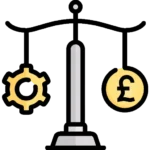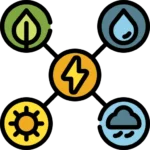Green business energy
Find the best green energy deal for your business
Just enter your business postcode…
Find the best green energy deal for your business
Just enter your business postcode…
Start saving now
Switching to green energy is simple. We’ve broken it down into three easy steps so your business can switch to a more sustainable energy plan with minimal effort. Here’s how:

Share a few basic details about your business, and we’ll gather personalised green energy quotes for you.

Review the different green energy plans based on cost, renewable sources, and contract length.

Once you’ve made your choice, our experts will handle the entire switch for you, making the process hassle-free.
Most business energy suppliers offer green energy tariffs alongside their standard options. These tariffs are often generated from renewable sources, such as wind and solar, while some also integrate low-carbon options like nuclear or carbon offsetting.
Here are the business energy suppliers that focus exclusively on green energy:

Renowned for its 100% renewable electricity across all tariffs, Octopus is a top pick for businesses aiming to go green. It also offers smart tariffs that help you save by optimising energy usage during off-peak hours, making it eco-friendly and cost-efficient.

Ecotricity supplies 100% renewable electricity from wind and solar power. Around 20% of their energy is self-generated, with the rest sourced from other renewable producers, ensuring a cleaner energy future.

Good Energy delivers 100% renewable electricity and offers a green gas tariff with 10% certified biomethane. The rest is offset through carbon reduction projects, making it a sustainable option for homes and businesses focused on lowering their carbon footprint.
Choosing green energy for your business can lead to numerous long-term benefits. By switching to renewable energy sources, you can:

Lower your environmental impact by using renewable energy sources like wind and solar that do not emit greenhouse gases.

Strengthen your business’s reputation by showcasing your commitment to sustainability by demonstrating improvements in corporate carbon reporting.

Securing a fixed-rate green energy tariff can protect your business from fluctuating energy prices, providing cost stability while supporting sustainability goals.

Green energy tariffs often come with business energy monitoring software that can help you eliminate unnecessary energy consumption.

Switching to a green energy tariff aligns your business with the global push toward net-zero emissions, reducing reliance on fossil fuels and supporting a cleaner future.
Finding the right renewable energy provider can be complex, but we make it simple. Our experts connect businesses with trusted green energy suppliers, ensuring you get the best deal while reducing your carbon footprint.
Whether you’re looking for renewable electricity, carbon-neutral gas, or expert advice on sustainability, we’re here to help.

We work with trusted UK green energy suppliers offering 100% renewable electricity and carbon-neutral gas, helping your business confidently switch to sustainable energy.

Our experts understand the green energy market and provide tailored recommendations, ensuring you choose the right supplier for your needs.

We compare suppliers and find the best green energy deals for your business for free. There are no hidden fees, just straightforward savings and hassle-free switching.
Key factors must be considered when comparing green energy options for your business. Read on to learn how to evaluate these options and find the best green tariff for your business.

Different suppliers may offer energy from various renewable sources, such as wind, solar, biomass, and hydroelectric. Consider the specific energy sources your supplier uses and whether these align with your sustainability goals.

Green energy tariffs often come with specific contract lengths and exit fees. Ensure the terms are flexible enough for your business needs, and check for any penalties if you decide to switch business energy suppliers before the contract ends.

Green energy tariffs are generally more expensive than standard energy plans due to the higher costs of sourcing renewable energy. While the price may be higher, it is important to assess the long-term sustainability benefits against the higher overall cost.

The reputation of your chosen business energy supplier is crucial. Look for a provider that is transparent about its renewable energy offerings, has good customer service, and offers a reliable energy supply.

Some green energy plans include additional features such as carbon offsetting, where a supplier invests in projects to neutralise the emissions associated with your gas consumption. Evaluate if these options are essential for your business.

Check if the supplier is certified by recognised green energy certification schemes, such as the Renewables Obligation Certificates (ROCs). This ensures that the energy you are purchasing is genuinely renewable.
There are three main types of green energy tariffs, each offering different benefits for businesses looking to reduce their environmental impact.
Below, we explore these options in more detail:

These tariffs are powered entirely by renewable sources such as wind, solar, hydro, and biomass. Most UK suppliers offer 100% renewable tariffs that are certified by the Renewable Energy Guarantees of Origin scheme.

Zero-carbon tariffs combine renewable energy with nuclear power, which is carbon neutral but not renewable. EDF is a leading supplier offering a zero carbon tariff incorporating electricity generated from their own fleet of nuclear power stations.

Carbon offset tariffs use energy from mixed sources, including gas power stations, but offset emissions through investments in sustainability projects, such as reforestation or renewable infrastructure development.
Switching to a green business energy tariff is as straightforward as switching to any other business energy tariff. The process typically involves choosing the right green business energy supplier for your business needs and following the same steps as a standard tariff switch.
For a more detailed guide on switching and understanding how green energy is delivered, visit our guide to switching business energy supplier.
We’ve also prepared a guide to how green business energy tariffs are delivered.